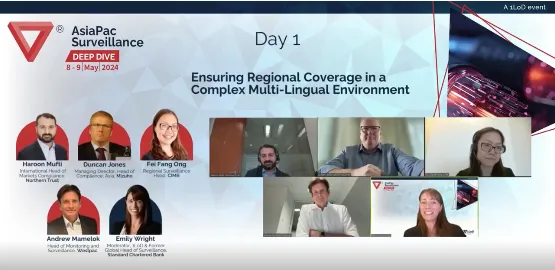
Navigating Language Barriers in the Asia Pacific Region's Electronic Communications Surveillance

As a moderator at the recent 1LoD conference, Asia Pacific Surveillance, I had the privilege of leading a thought-provoking discussion on the challenges banks face in conducting communications surveillance across the diverse linguistic landscape of the region.
The session, titled "Ensuring Regional Coverage in a Complex Multi-Lingual Environment," brought together some fantastic industry experts to share their insights and strategies for tackling this critical issue.
One of the key takeaways from the discussion was the potential for prioritising the use of AI for translation, as a first-step strategy. By focusing on achieving high-quality translations, banks can then leverage the existing English-oriented programs they have in place that utilize Natural Language Processing (NLP) and Lexicons for detection purposes. This approach creates efficiency and consistency in programs allowing teams to focus on English for detection, allocating AI to the task of translation. It also offers a clear path forward for vendors and in-house developers supporting surveillance, as it highlights the clear priority that needs to be given to better translation. Once this has been has been effectively addressed, surveillance teams can utilize and optimise any alerting strategy they want, in a single language.
It's interesting to note that many communications vendors are currently scrambling to develop translation capabilities that meet the accuracy needed for surveillance purposes, with many outsourcing this function to third-parties. This observation may serve as a wake-up call for these vendors to reassess their priorities and invest in robust translation solutions, rather than multi-language detection strategies. Some institution I have spoken with outside the event have shared they are developing automated translation capability in-house to try and improve the quality, cost and speed of delivery of this now-critical service.
During the session, I was surprised to learn from the audience poll that the adoption of AI for translation purposes remains relatively low among banks in Asia Pacific. This suggests that, even in 2024, many banks still rely on human translators, and have teams proficient in six or seven languages to review flagged communications, before conducting surveillance. The limited use of widely available tools like Google Translate, which has provided reasonable accuracy for a number of common-use languages in the region for a significant time, indicates a slow uptake of technology in this area.
The discussion also highlighted the contrasting approaches taken by banks in the region to address language diversity. Some banks takes efforts to cover all languages encountered that constituted business communications, while others bank opted to restrict business communications to English where possible, granting exceptions only on a case-by-case basis; many take a path in-between. These different strategies underscore the unique challenges posed by Asia Pacific's linguistic landscape and the need for tailored solutions that align with each bank's specific requirements and risk appetite.
As the session unfolded, it became increasingly clear that there is no one-size-fits-all approach to tackling the language barrier in communications surveillance. Banks must carefully consider their resources, regulatory obligations, and the linguistic profile of their customer base when developing their surveillance strategies. There was some optimism that by leveraging the power of AI and machine translation, while also maintaining a degree of human oversight, banks can aim to strike a balance between efficiency and effectiveness in monitoring communications across multiple languages.
In conclusion, the session provided valuable insights into the challenges and opportunities banks face in conducting communications surveillance in Asia Pacific. As the region, industry and technology all continue to evolve, it is imperative that surveillance teams remain proactive in adapting their strategies to keep pace with the ever-changing landscape.
If you are grappling with this, or related surveillance issues, feel free to reach out to me for an informal discussion about how I may assist.
